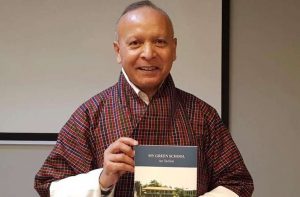
Maintaining a positive balance of mind takes constant practice; it is not as simple as it may sound. It is easier to lose that balance than it is to gain it, and that’s where Right Mindfulness comes in.
When talking about Right Mindfulness, in order to avoid the hindrances of ignorance and delusion, and in order to explain accurately, without uncertainty or recourse to our own ideas, we shall adhere to the words of the Buddha as they are translated and expounded by respected Pali scholars and teachers of the Dhamma.
Venerable Nyanaponika Mahathera explains in The Road to Inner Freedom:
Right Mindfulness is the quality of awareness. It ensures complete awareness of all activities of the body as they occur, complete awareness of all sensations and feelings as they occur, complete awareness of all activities of the mind as they occur and complete awareness of all mental objects when the appropriate situations arise. This attitude of complete awareness brings about powerful results. It sharpens to the finest degree man’s powers of observation, induces the deepest calm and ensures that nothing is said or done or thought unguardedly or hastily, mechanically or without deliberation. He who develops this factor is able to take count of every single and minute activity of the mind, even such activities as are generally considered to occur when the mind is passive and receptive; so penetrating and powerful is his sense of awareness. (70)
The point of Right Mindfulness is to realize a total awareness of the true nature of phenomena as objects of thought, the way they really are. This takes mind-training and can only be realized by disciples advanced in this discipline, which Ven. Nyanaponika outlines in The Heart of Buddhist Meditation.
Ledi Sayadaw explains the problem of focusing such awareness in The Noble Eightfold Path and its Factors Explained:
The minds of most beings are never steady but fly about here and there. They have no control over their minds and so cannot fix them steadily on a subject of meditation. As they cannot control their minds, they resemble mad or mentally deranged persons. . . . To eliminate the unsteady and flighty mind and to fix it continuously on the meditation subject one has to practice the Four Applications of Mindfulness. (56)
Ven. Nyanatiloka Mahathera translates the words of the Buddha on this particular subject:
“The only way that leads to the attainment of purity, to the overcoming of sorrow and lamentation, to the end of pain and grief, to the entering upon the right path and the realization of Nibbana, is by the Four Foundations of Mindfulness.”
We will, of course, want to know what these foundations are, and the Buddha tells us:
“Herein the disciple dwells in contemplation of the body, in contemplation of feeling, in contemplation of the mind, in contemplation of the mind-objects; ardent, clearly comprehending them and mindful after putting away worldly greed and grief.”
What this means is that the disciple should examine the root of his bodily perceptions, his feeling perceptions, his mental perceptions, and the objects of contemplation of the mind, to bring them out in the light and to examine them in the immediacy of the present moment to determine if they are confounded with delusion and attachment. Nothing is what it seems because the mind embellishes experience. (61)
Likewise, Bhikkhu Bodhi helps to explain when he writes in The Noble Eightfold Path:
Clearing up the cognitive field is the task of right mindfulness. Mindfulness brings to light experience in its pure immediacy. It reveals the object as it is before it has been overlaid with interpretations. To practice mindfulness is thus a matter not so much of doing but of undoing: not thinking, not judging, not associating, not planning, not imagining, not wishing. All these “doings” of ours are modes of interference, ways the mind manipulates experience and tries to establish its dominance. Mindfulness undoes the knots and tangles of these doings by simply noting. It does nothing but note, watching each occasion of experience as it arises, stands, and passes away. In the watching there is no room for clinging, no compulsion to saddle things with our desires. There is only a sustained contemplation of experience in its bare immediacy, carefully precisely and persistently. (86)
In other words, the mind observes, free of meanderings, the clear nature of every experience, by separating the original experience from its embellishments and examining it closely to see what it really is.
Buddhists practice clearing the cognitive field in four ways, which can be worked on concurrently or on a step-by-step basis. The first is to examine the material side of existence through contemplation of the body.
To enable us to quiet or calm the mind so that it is in a stable state to contemplate the body’s actions, the Buddha tells us about breath meditation:
Herein the disciple retires to the forest, to the foot of a tree, or to a solitary place, seats himself with legs crossed, body erect, and with mindfulness fixed before him, mindfully he breathes in, mindfully he breathes out. When making a long inhalation, he knows: “I make a long inhalation”; when making a long exhalation, he knows: “I make a long exhalation.” When making a short inhalation, he knows: “I make a short inhalation”; when making a short exhalation, he knows: “I make a short exhalation.” “Clearly perceiving the entire (breath-) body, I shall breathe in: thus he trains himself; clearly perceiving the (breath-) body, I shall breathe out: thus he trains himself.” “Calming this bodily function, I shall breathe in”: thus he trains himself; Calming this bodily function, I shall breathe out: thus he trains himself.
Thus, he dwells in contemplation of the body either with regard to his own person or to other persons or to both. He beholds how the body arises; beholds how it passes away; beholds the arising and passing away of the body. A body is there . . . (Nynanatiloka 61)
Mindfulness of breathing has several uses. It is used for tranquilization and calming the body, preparatory to the achievements of higher states called absorptions (Pali: jhana) and preparatory to the development of Insight Wisdom.
It makes the disciple realize that he is not the body he is contemplating and that the personality he thought he was contemplating does not actually exist. Through examination of the origin of the breath, he gains a physical stability or composure, in which state he has a better control over the mind. Eventually, as development continues, the practitioner realizes there is a mental process outside of self, watching the arising and passing of breath, and this brings him closer to an understanding of non-ego.
References
Bodhi, Bhikkhu. 1984. The Noble Eightfold Path. Kandy: Buddhist Publication Society.
Sayadaw, Ledi. 1977. The Noble Eightfold Path and its Factors Explained. Kandy: Buddhist Publication Society.
Mahathera, Narada. 1980. The Buddha and His Teachings. Kandy: Buddhist Publication Society.
Mahathera, Nyanaponika. 1982. The Road to Inner Freedom. Kandy: Buddhist Publication Society.
———. 1983. The Heart of Buddhist Meditation. London: Rider Presss.
Mahathera, Mahathera. 1967. The Word of the Buddha. Kandy: Buddhist Publication Society.







